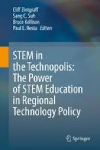- About MAA
- Membership
- MAA Publications
- Periodicals
- Blogs
- MAA Book Series
- MAA Press (an imprint of the AMS)
- MAA Notes
- MAA Reviews
- Mathematical Communication
- Information for Libraries
- Author Resources
- Advertise with MAA
- Meetings
- Competitions
- Programs
- Communities
- MAA Sections
- SIGMAA
- MAA Connect
- Students
- MAA Awards
- Awards Booklets
- Writing Awards
- Teaching Awards
- Service Awards
- Research Awards
- Lecture Awards
- Putnam Competition Individual and Team Winners
- D. E. Shaw Group AMC 8 Awards & Certificates
- Maryam Mirzakhani AMC 10 A Awards & Certificates
- Two Sigma AMC 10 B Awards & Certificates
- Jane Street AMC 12 A Awards & Certificates
- Akamai AMC 12 B Awards & Certificates
- High School Teachers
- News
You are here
STEM in the Technopolis: The Power of STEM Education in Regional Technology Policy

Publisher:
Springer
Publication Date:
2020
Number of Pages:
341
Format:
Hardcover
Price:
109.99
ISBN:
978-3030398507
Category:
General
[Reviewed by , on ]
Deborah Gochenaur
06/17/2023
This volume makes the case that the training of future STEM employees should begin as early as possible, as early as elementary grades. Case studies include industry, government, K-12 school systems and academia stakeholders coming together to collaborate on not only economic growth but also innovations in social inclusion and infrastructure. Improving K-12 students’ belief systems on how they can help improve their own neighborhoods is a key component of many included projects.
Chapters in Part 1 of the book make the case that a foundational principle of the STEM education of our young people must be a critical component of all regional technology and development policy in a form of technopolis. The original technopolis model was published in 1989 and considered the collaboration between universities, local businesses, and large companies to energize the building of economic technological momentum. Chapter 4 fully investigates these early beginnings and would be of great interest to mathematical historians.
The next two sections offer case studies at the state and national level. Part 2 of the book highlights regional and statewide initiatives from around the globe that have utilized connections in their own technopolis to build programs in the public-school systems, working to build their STEM workforce. Part 3 of the book highlights how two countries have leveraged national policy to drive changes in the education of children and the inclusion of STEM experiences for children of all ages.
The authors end the book with a model for cultivating these ideas in the reader’s own community, as the readers work towards building a technopolis. Ideas include strategies and a discussion of barriers of roadblocks, tools, and techniques gathered from the case studies in the volume.
Bottom Line: The volume includes both color and black and white charts, diagrams and several photos. This book would make an interesting read for anyone interested in the connection between STEM education, educational policy, and governmental policy. This would include non-profit executives, industry leaders, school leaders and government policymakers.
Dr. Deborah Gochenaur is an Associate Professor at Shippensburg University in Pennsylvania with a B.S. in Mathematics from Penn State Harrisburg and a M.S. in Mathematics from Shippensburg University, and a Ph.D. in Mathematics Education for American University. She is an active member of mathematics and mathematics education organizations, serving on state and national committees.
See the publisher's website.
- Log in to post comments




